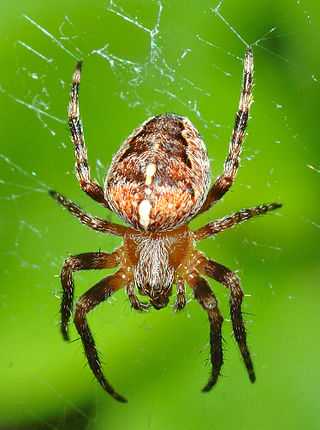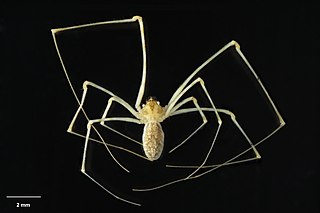
Norman Ira Platnick was an American biological systematist and arachnologist. At the time of his death, he was a professor emeritus of the Richard Gilder Graduate School and Peter J. Solomon Family Curator Emeritus of the invertebrate zoology department of the American Museum of Natural History. A 1973 Ph.D. recipient at Harvard University, Platnick described over 1,800 species of spiders from around the world, making him the second most prolific spider taxonomist in history, behind only Eugène Simon. Until 2014 he was also the maintainer of the World Spider Catalog, a website formerly hosted by the AMNH which tracks the arachnology literature, and attempts to maintain a comprehensive list, sorted taxonomically, of every species of spider which has been formally described. In 2007 he received the International Society of Arachnology's Bonnet award, named for Pierre Bonnet, in recognition of his work on the catalog.

Araneoidea is a taxon of araneomorph spiders, termed "araneoids", treated as a superfamily. As with many such groups, its circumscription has varied; in particular some families that had at one time been moved to the Palpimanoidea have more recently been restored to Araneoidea. A 2014 treatment includes 18 families, with the araneoids making up about 26% of the total number of known spider species; a 2016 treatment includes essentially the same taxa, but now divided into 17 families.

Unicorn ("one horn", in Latin) is a genus of goblin spiders from South America, containing seven species that occur predominantly in high elevation, semi-desert regions of Bolivia, Chile, and Argentina. Individuals are relatively large for goblin spiders, measuring up to 3.0 mm (0.12 in) in body length. The genus name refers to a characteristic pointed projection between the eyes and jaws of males. In at least one species, broken-off tips of the male pedipalps have been found within the genitalia of females, postulated as a means of sperm competition. Unicorn possesses several traits that suggest it is a relatively "primitive" member of the Oonopidae, and is classified with other similar, soft-bodied goblin spiders in the subfamily Sulsulinae.

Caponiidae is a family of ecribellate haplogyne spiders that are unusual in a number of ways. They differ from other spiders in lacking book lungs and having the posterior median spinnerets anteriorly displaced to form a transverse row with the anterior lateral spinnerets. Most species have only two eyes, which is also unusual among spiders. A few species of Caponiidae variously have four, six or eight eyes. In some species the number of eyes will increase when the spiderling changes its skin as it grows towards adulthood.
Crassanapis is a genus of South American araneomorph spiders in the family Anapidae, first described by Norman I. Platnick & Raymond Robert Forster in 1989.
Elanapis is a genus of South American araneomorph spiders in the family Anapidae, containing the single species Elanapis aisen. It was first described by Norman I. Platnick & Raymond Robert Forster in 1989, and has only been found in Chile.
Gertschanapis is a genus of North American araneomorph spiders in the family Anapidae, containing the single species, Gertschanapis shantzi. It was first described by Norman I. Platnick & Raymond Robert Forster in 1990, and has only been found in United States.
Minanapis is a genus of araneomorph spiders in the family Anapidae, first described by Norman I. Platnick & Raymond Robert Forster in 1989.
Pecanapis is a genus of South American araneomorph spiders in the family Anapidae, containing the single species, Pecanapis franckei. It was first described by Norman I. Platnick & Raymond Robert Forster in 1989, and has only been found in Chile.
Sheranapis is a genus of South American araneomorph spiders in the family Anapidae, first described by Norman I. Platnick & Raymond Robert Forster in 1989. As of April 2019 it contains only three species, all found in Chile.
Sofanapis is a genus of South American araneomorph spiders in the family Anapidae, containing the single species, Sofanapis antillanca. It was first described by Norman I. Platnick & Raymond Robert Forster in 1989, and has only been found in Chile.
Mangua is a genus of araneomorph spiders in the family Physoglenidae that first described by Raymond Robert Forster in 1990. Originally placed with the Synotaxidae, it was moved to the Stiphidiidae in 2017.

Meringa is a genus of Polynesian araneomorph spiders in the family Physoglenidae that was first described by Raymond Robert Forster in 1990. Originally placed with the Synotaxidae, it was moved to the Physoglenidae in 2017.

Nomaua is a genus of Polynesian araneomorph spiders in the family Physoglenidae that was first described by Raymond Robert Forster in 1990. Originally placed with the Linyphiidae, it was moved to the Synotaxidae in 1990, and is now considered a senior synonym of Wairua.

Pahoroides is a genus of Polynesian araneomorph spiders in the family Physoglenidae that was first described by Raymond Robert Forster in 1990.
Paratupua is a monotypic genus of araneomorph spiders in the family Physoglenidae found in Victoria, Australia. It contains the single species, Paratupua grayi. Though it's sometimes misspelled Paratupa, the correct spelling is "Paratupua".
Physoglenes is a genus of Chilean araneomorph spiders in the family Physoglenidae that was first described by Eugène Louis Simon in 1904. It has been listed under several different families, including Leptonetidae, Pholcidae, Synotaxidae, and most recently, Physoglenidae.
Synotaxus is a genus of araneomorph spiders in the family Synotaxidae that was first described by Eugène Louis Simon in 1895. Originally placed with the tangle web spiders, it was moved to the family Synotaxidae in 2017.

Physoglenidae is a family of araneomorph spiders first described by Alexander Petrunkevitch in 1928 as a subfamily of Pholcidae. It was later moved to Synotaxidae until a study in 2016 showed that they formed a distinct clade.
Tupua is a genus of Tasmanian araneomorph spiders in the family Physoglenidae that was first described by Norman I. Platnick in 1990.







